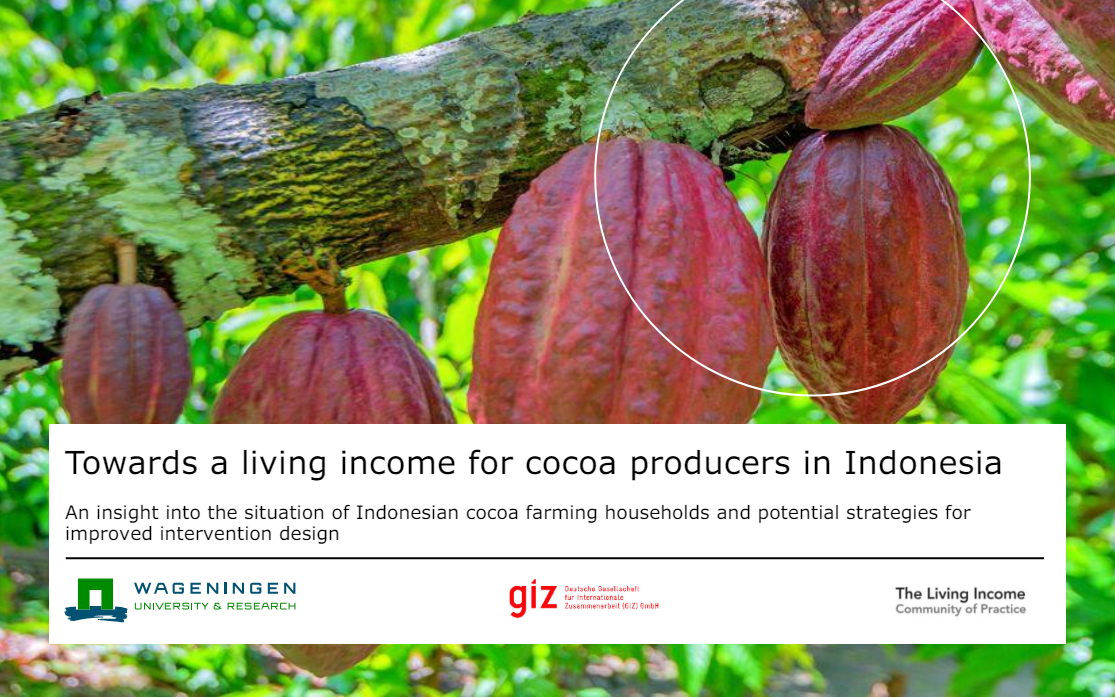Empowering Cocoa Farming Households in Indonesia
Bridging the Living Income Gap of Smallholder Cocoa Producers Through Addressing Systemic Barriers and Tailored Solutions

By Nina Bellini Motovska and Yuca Waarts
The concept of a living income has gained traction among companies, NGOs, and governments, including the EU, Dutch, German, Belgian, and Luxembourg governments, which have jointly signed a declaration on living wages and incomes. In various sectors, including the cocoa industry, stakeholders have established targets for smallholder farmer and worker households to achieve a living income. However, for many countries and regions, there is insufficient publicly available data and information on the income status of smallholder farming households. An analysis of such data is crucial as it offers valuable insights into strategies capable of narrowing the living income gap. A recently published WUR study addresses this by sharing data and insights on Indonesian cocoa farming households, including analyses on how these households could substantially improve their net household income and greatly reduce or fully close their gap to a living income.
Before delving into the study findings, it is important to note that the currently high futures market prices for cocoa, which more than doubled since the beginning of 2024, and their implications for farm-gate prices in Indonesia, are not included in the WUR study as the analysis are conducted for the 2021-2022 cocoa season. Consequently, farmers in the study may presently be receiving higher prices, implying that more households could be earning a living income than what is presented. The research team will keep an eye out for the possible impacts of these price increases on Indonesian cocoa households and the Indonesian cocoa sector in future studies.
The WUR study aggregated data from two endline evaluations using household surveys for the season 2021-2022. These were part of two longitudinal impact evaluation studies implemented between 2016 and 2022. The study results showed that cocoa farming is an important livelihood pillar for many households across Indonesia. Yet, for the majority of cocoa-producing households, earning a living income was not attainable based on their characteristics at the time of the study. Less than 2% of households in the study sample earned a living income, with over half of the households living in a situation of severe poverty.
The study revealed a disparity in farm sizes between households earning a living income and those not meeting their living income benchmark. Those achieving a living income boast nearly double the farm size compared to others, indicating a crucial link between farm size and income levels. However, larger farm sizes do not necessarily translate to higher cocoa productivity per hectare. Therefore, it is the farm size that drives the higher income levels but not the cocoa productivity per hectare per se.
The authors employed three methods to assess household characteristics influencing households’ ability to earn a living income. All three analyses reveal the importance of cocoa farm size, total cocoa volume produced, and ability to invest in cocoa as strong determinants related to the household’s ability to earn a living income. Almost 85% of households in the studied sample face high barriers to earning a living income in terms of limited cocoa farm size (1.24 ha on average), suboptimal cocoa production volumes (74% of the households in this group were producing less than 600 kg of cocoa per year), and the inability to make investments into cocoa production (they invest around USD 60 in total cocoa cash production costs per farm).
Tailor-made intervention strategies are needed to address challenges faced by different segments of cocoa-producing households. Cash transfers and price increases can serve as catalysts for income growth, enabling households to make crucial investments in cocoa production or diversification. The majority of the poorest households can best be supported by off-farm income generation activities. The relatively wealthier households would benefit from on-farm diversification. Agronomic efforts to boost yields through investments would primarily favor the small proportion of households that are more resource endowed and have in general smaller living income gaps.
However, the efficacy of several of these interventions remains uncertain, necessitating further research to gauge their impact on household incomes. By addressing systemic barriers and embracing tailored solutions, we can pave the way for a brighter future for cocoa farmers and their families in Indonesia.
Want to find out more? Read the full paper: Towards a living income for cocoa producers in Indonesia: An insight into the situation of Indonesian cocoa farming households and potential strategies for improved intervention design
